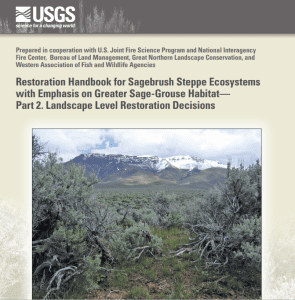Sagebrush
View article.
This study explored recovery of Wyoming big sagebrush (Artemisia tridentata ssp.wyomingensis) and basin big sagebrush (A. tridentata ssp. tridentata) communities following fire in the northern Columbia Basin (Washington, USA). Density of large–mature big sagebrush plants and percentage cover of big sagebrush were higher with time since fire and in plots with more precipitation during the winter immediately following fire, but were lower when precipitation the next winter was higher than average, especially on soils with higher available water supply, and with greater post-fire mortality of mature big sagebrush plants. Bunchgrass cover 5 to 28 years after fire was predicted to be lower with higher cover of both shrubs and non-native herbaceous species, and only slightly higher with time. Post-fire recovery of big sagebrush in the northern Columbia Basin is a slow process that may require several decades on average, but faster recovery rates may occur under specific site and climate conditions.
View article.
This study investigated the effects of container volume and fertilization on the performance of nursery-grown Wyoming big sagebrush seedlings following outplanting. Researchers found that container volume may influence seedling morphology and optimize establishment, while field fertilization, especially during spring outplanting when planting sites have low moisture availability, may hinder first-year survival.
Access app and tool.
The Sage Grouse Initiative Interactive Web App is a tool to catalyze and improve habitat conservation efforts across the western United States. It presents cutting-edge geospatial data covering 100 million acres, which helps visualize, distribute, and interact with information about the sagebrush-steppe ecosystem.
View handbook.
This handbook is intended to assist decision makers in determining landscape objectives, to identify and prioritize landscape areas where sites for priority restoration projects might be located, and to aid in ultimately selecting restoration sites guided by criteria used to define the landscape objectives. The landscape restoration decision tool is structured in five sections that should be addressed sequentially. Each section has a primary question or statement followed by related questions and statements to assist the user in addressing the primary question or statement.
View posters and postcards.
The Sage Grouse Initiative developed posters and postcards designed to promote conversations about the importance of taking care of sagebrush community plant health and diversity, above and below ground.
View infographic.
This infographic developed by SageSTEP.org describes sagebrush steppe restoration prioritization and methods to benefit sage-grouse habitat.
View handbook.
This handbook discusses concepts surrounding landscape and restoration ecology of sagebrush ecosystems and greater sage-grouse that habitat managers and restoration practitioners need to know to make informed decisions regarding where and how to restore specific areas, by providing:
- Descriptions of plant dynamics of sagebrush steppe ecosystems and their responses to major disturbances, fire, and defoliation.
- Introductions of the concepts of ecosystem resilience to disturbances and resistance to invasions of annual grasses within sagebrush steppe.
- Introductions to soils and ecological site information will provide insights into the specific plants that can be restored in a location.
- Descriptions of concepts of landscape ecology that aid decisions regarding habitat restoration.
- Overviews of restoration techniques for sage-grouse habitat restoration.
- Descriptions of the critical nature of monitoring for adaptive management of sagebrush steppe restoration at landscape- and project-specific levels.
View abstracts.
These abstracts of recent papers on rangeland management in the West were prepared by Charlie Clements, Rangeland Scientist, USDA Agricultural Research Service, Reno, NV.
View field guide.
This field guide provides a framework for rapidly evaluating post-fire resilience to disturbance, or recovery potential, and resistance to invasive annual grasses, and for determining the need and suitability of the burned area for seeding. The framework identifies six primary components that largely determine resilience to disturbance, resistance to invasive grasses, and potential successional pathways following wildfire, as well as the information sources and tools needed to evaluate each component.
The components are: (1) characteristics of the ecological site; (2) vegetation composition and structure prior to the wildfire; (3) fire severity; (4) post-wildfire weather; (5) post-wildfire management, especially grazing; and (6) monitoring and adaptive management.
The tools provided are: (1) a conceptual model of the key components that largely determine resilience to disturbance and resistance to invasive annual grasses of the burn area, (2) a guide to evaluate post-wildfire severity, (3) indicators to estimate pre-wildfire plant composition and structure if not known, and (4) an evaluation score sheet to rate an area’s potential post-wildfire resilience to disturbance, resistance to invasive annual grasses and, thus, the need for seeding and probability of success.




